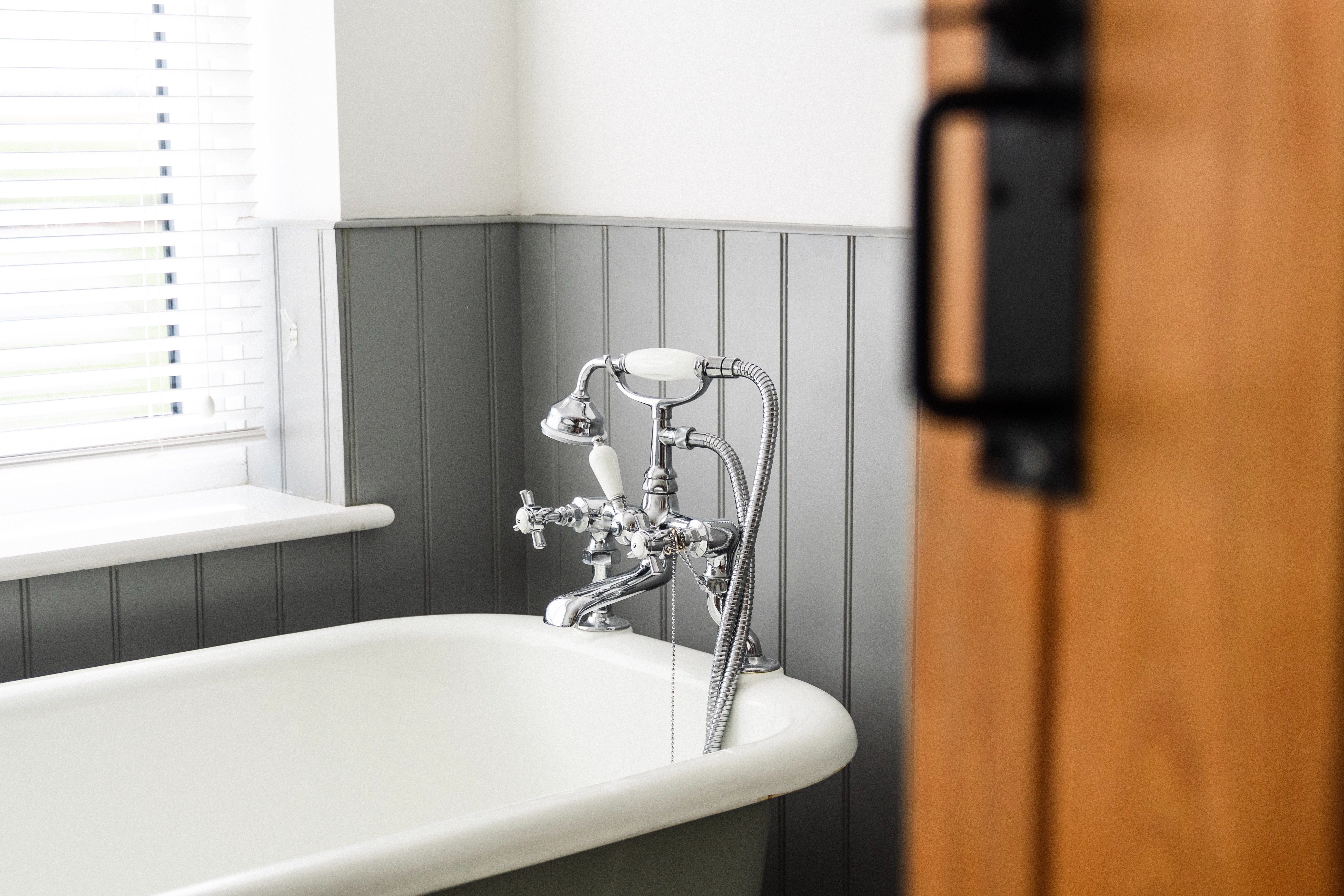Express Doors Direct ▸ Blog ▸ Which Doors are Best for Bathrooms?
When you’re redecorating your bathroom, the focus tends to be on the bathroom suite. Can you squeeze in a claw-foot victorian tub? Would a rainfall shower be a revolutionary investment?
Then there is tiles, towels and storage to consider. The extensive needs for the room versus the often limited space. It’s no surprise that bathroom doors are often a last-minute decision, picked after barely a moment’s thought.
This is a shame as bathroom doors and their handles can make a big difference to how your room looks as well as bring other functional features. For example, an opaque glass bathroom door will bring extra light, while a laminate door is almost maintenance-free. Bathrooms tend to be smaller, making sliding doors a great choice to save space.
There are plenty of things you should consider when you choose a door for your bathroom, beyond the door’s design. This article will look at the things you may want to consider, including the material it is made of, what type of door is best to meet the needs of your living spaces and other door features you may want.
What Should a Bathroom Door be Made of?
When picking a new bathroom door for your home, the first thing you should consider is what are bathroom doors made of?
Like all internal doors, there is a choice of materials but a bathroom door does have particular requirements.
It is one door that is guaranteed to get a lot of use, so it needs to be robust. Bathrooms can be prone to spills and splashes of sticky liquids like cleansers, moisturisers and medicines, so an easy to clean surface will always be a bonus.
Finally, it needs to provide privacy, and a solid-feeling construction will be a benefit too.
Picking the right material can be key. Here’s a rundown of common interior door materials that you can choose from:
A Wooden Bathroom Door
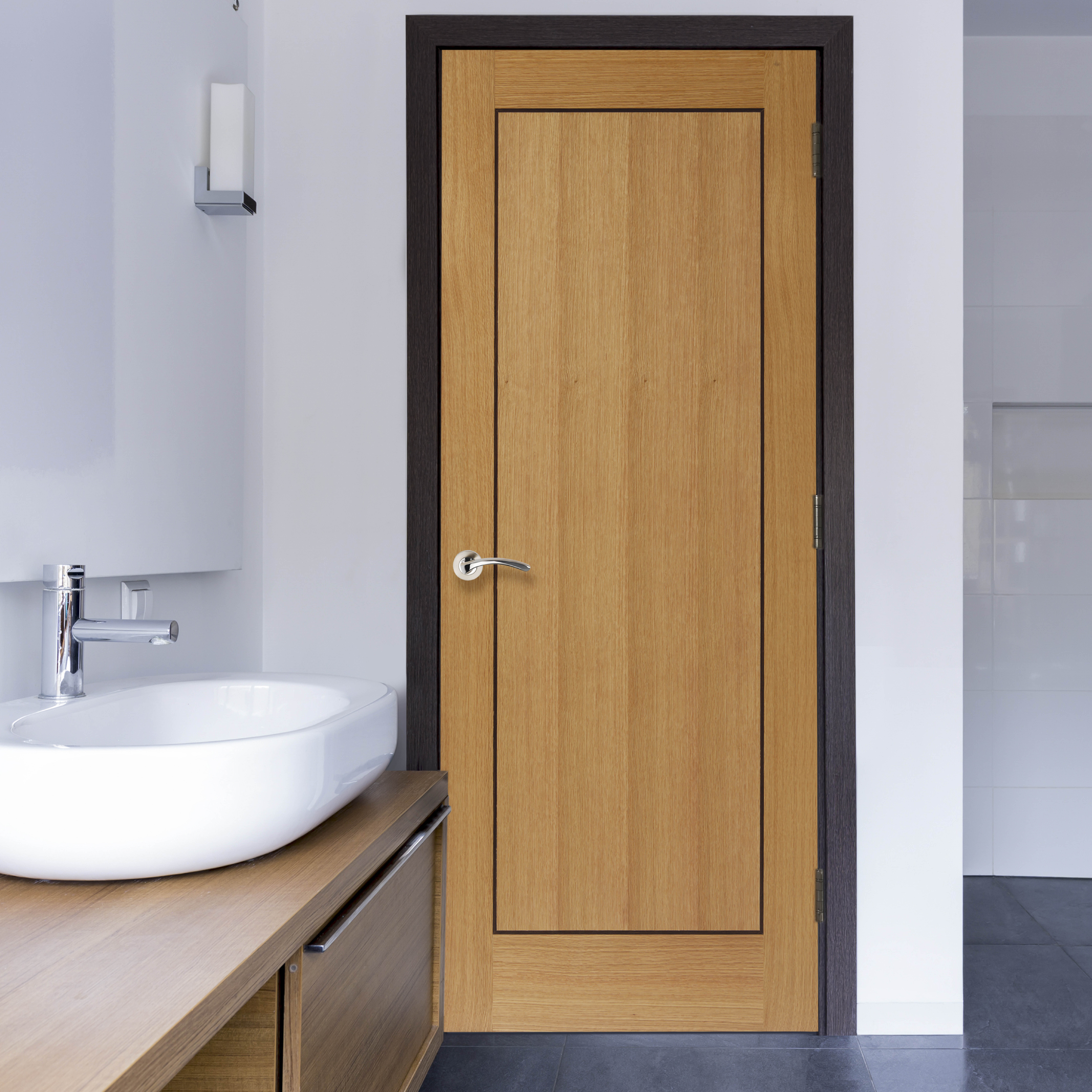
A classic choice for any internal door, wood is a flexible, durable material. If it’s finished correctly, it’s perfect for bathroom doors. With a coat of paint, wax or varnish you can seal it against moisture and its solid construction creates a strong sense of privacy.
Wooden doors are also a good insulator against sound and heat, so you won’t have to worry about anyone hearing you sing in the shower or having to clamber out into an icy draft.
Of course, even if you decide to get a wooden door, you will still want to know which wood is best for bathroom doors.
All the standard options apply. Pine is cheaper, but less long-lasting and can look low-quality. Oak or walnut are more expensive options, but they will add drama and aesthetic appeal.
If solid wood doors are out of your budget, you can always compromise with a veneered, engineered core door.
Hollow-core bathroom doors are low budget but lack the weight and quality of solid wood. Alternatively, a solid core oak veneered door will have all the practical benefits (and beauty!) of a solid wood door, but at a lower cost.
Laminate Doors
Laminate is another popular choice for bathrooms. The laminate surface is moisture resistant, to keep the door from swelling, warping or rotting.
Another benefit is how easy to clean a laminate surface is. You won’t have to worry about splattered soap suds drying on the back of the door – a laminate door will let you wipe off any residue without effort or damage to the door. Even rock-hard toothpaste remains should be quick work.
In terms of which laminate is best for bathroom doors, that will be a personal decision. Prefinished laminate doors are available in a wider range of colours than wood ones, including greys and blacks. This makes them a great choice for modern, minimalist or Scandinavian room designs.
If you’re looking for a traditional wood finish, then many laminate doors will incorporate a rich wood grain pattern on their design too. A classic white door is also an option.
Other Door Materials
Laminate and wooden bathroom doors are the most popular choices but there are other options including PVC doors, steel doors and fibreglass doors. All these modern door materials will have their own benefits but one of their major drawbacks is that they are harder to source. Steel bathroom doors, in particular, can also be expensive. You will need high-quality ones to withstand moisture and humidity.
Which Type of Door is Best for the Bathroom?
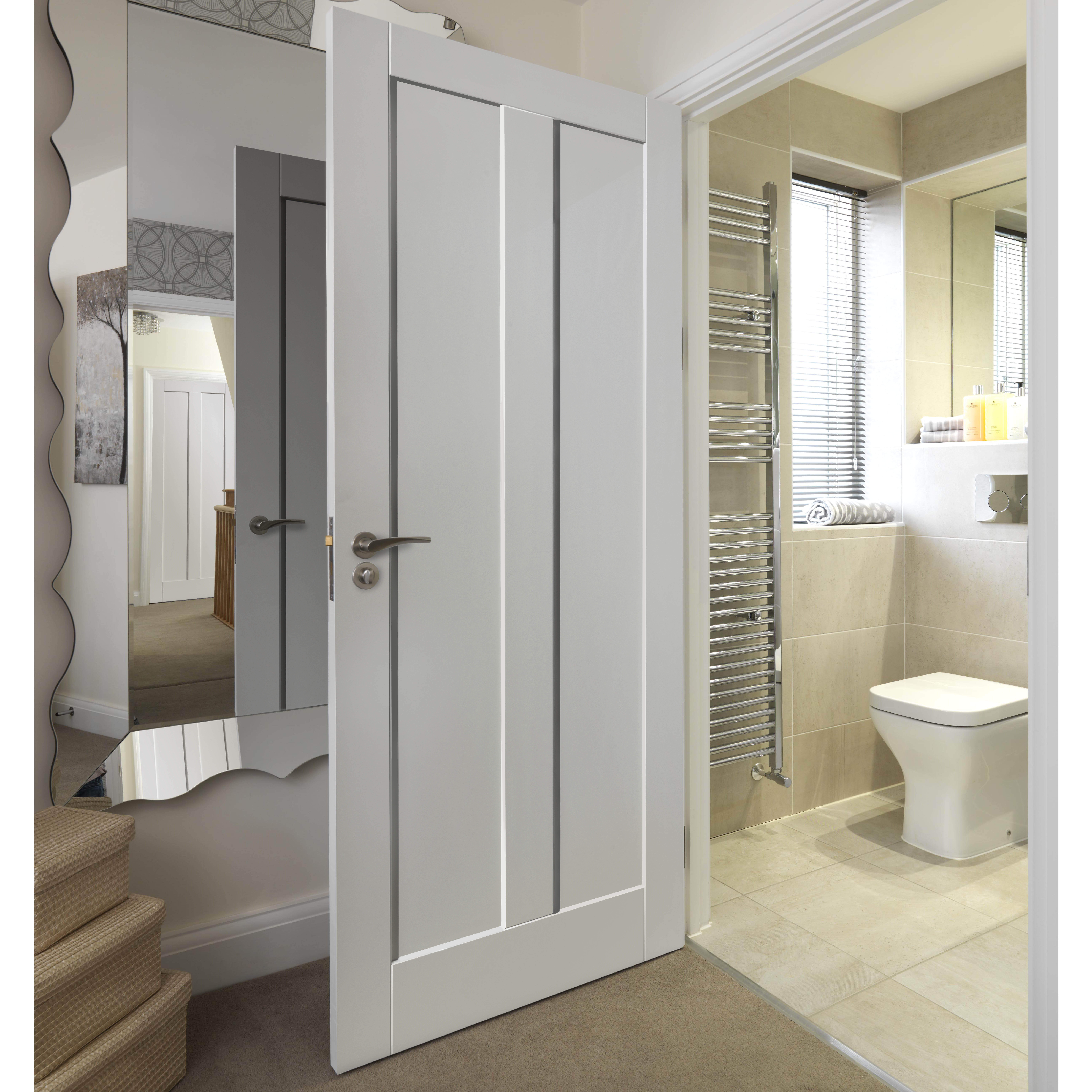
The bathroom is often the smallest room in the house, with only just enough space to fit the actual bathroom suite in. Additional space is usually at a premium, with extra storage a priority for any spare footage.
This makes your bathroom the perfect place to experiment with space-saving door types like pocket, sliding and folding doors.
Are sliding doors good for the bathroom?
Internal sliding doors are a great choice for a bathroom as they take up barely any space.
Hung from a top rail, when you open a sliding door it simply slides parallel to the wall. This means it takes up no floor space at all. A definite benefit for the smallest room in the house.
The main drawback of this type of internal door though is the visible mechanism. Pair the stark, dramatic bar with a brace and ledge cottage or barn-style door and you get a wonderful rustic feature. But it can be clunky or obtrusive in sleeker, minimalist interiors.
Are bathroom pocket doors a good idea?
A pocket door works in the same way as a sliding door, by moving along a track to open. The difference is that the track for a pocket door runs *inside* the wall. So when the door is open, the door itself will be hidden from view.
The work required to create the pocket for this type of door can be expensive. It can also be intrusive. Especially when you consider how integral a bathroom is to any home.
However, pocket doors do look amazing, giving a sleek, stylish feel to any home. And they are very convenient as they take up barely any space.
If you’re already investing in structural or deeper reconfigurations of your bathroom, they are a fantastic option.
Are bifold doors good for the bathroom?
Folding bathroom doors are another brilliant choice to help save floor space. These doors are made up of multiple small panels arranged together, that open by folding (or concertinaing) back on themselves.
A wooden bifold door can be an expensive option but does offer the convenience of pocket doors without the need for such significant work to get them installed. They open completely within the doorway, meaning you lose no space outside or inside the room.
They even leave your walls free for pictures, mirrors and towel rails which can be useful in a bathroom.
Are flush bathroom doors a good idea?
Of course, regular doors like flush and panel ones, are also popular for use in bathrooms. Not all bathrooms are so small that space-saving doors are needed, and flush doors don’t need any difficult work to install.
Flush doors can have an edge over panel doors for bathrooms. Their smooth finish is easier to clean and stop any condensation pooling in cracks or crevices.
Are French doors good for the bathroom?
If ‘space-saving’ isn’t your kind of thing, then installing a set of French doors into your bathroom will let you turn your doorway into a grand entrance.
French doors come in pairs, meaning they aren’t a particularly practical option for smaller homes. They do make an impact though, turning your doorway into a full-on feature. Having both doors open, can also help make two spaces flow into one which can be a pleasant option for ensuites in a master bedroom.
Bathroom Door Sizes
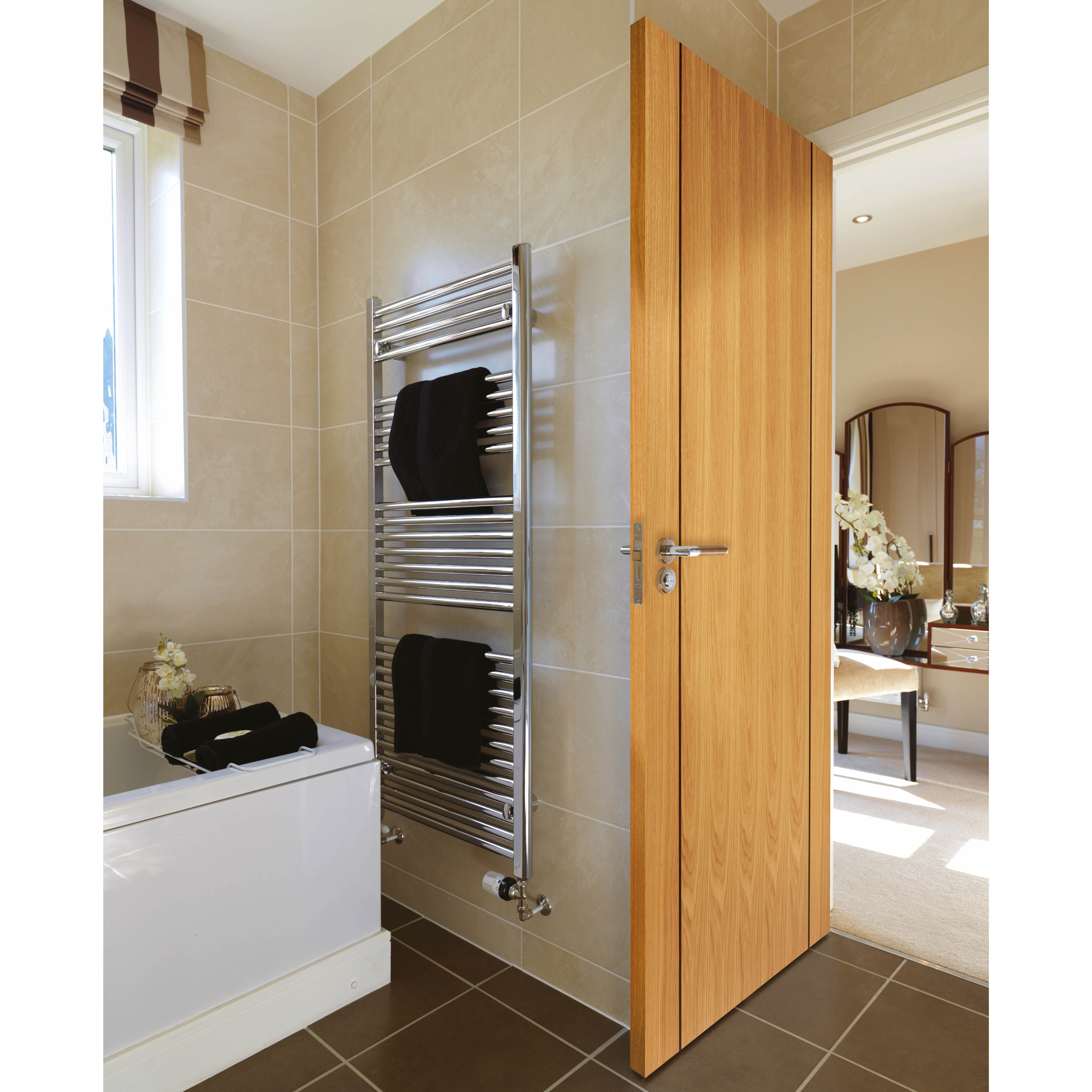
When it comes to the question of ‘what is standard bathroom door size’, the answer is the same as any other internal door.
Even though the bathrooms themselves tend to be a lot smaller, internal doorways have a relatively standard size. This means they range from 1981mm-2032mm tall and are a minimum of 35mm thick.
The minimum width for a bathroom door is 610mm whilst the standard size is around 860mm. Most interior doors are available in a range of widths, but with a wooden or laminate door, you will usually be able to trim the door too.
If you’d like to know more, you can take a look at our internal door size guide.
Other Things to Consider…
All of the above properties are things you would probably consider before buying any internal door. However, there are also some factors that relate specifically to bathroom doors that you should think about before you settle on a purchase.
Glass panels and frosted glass doors
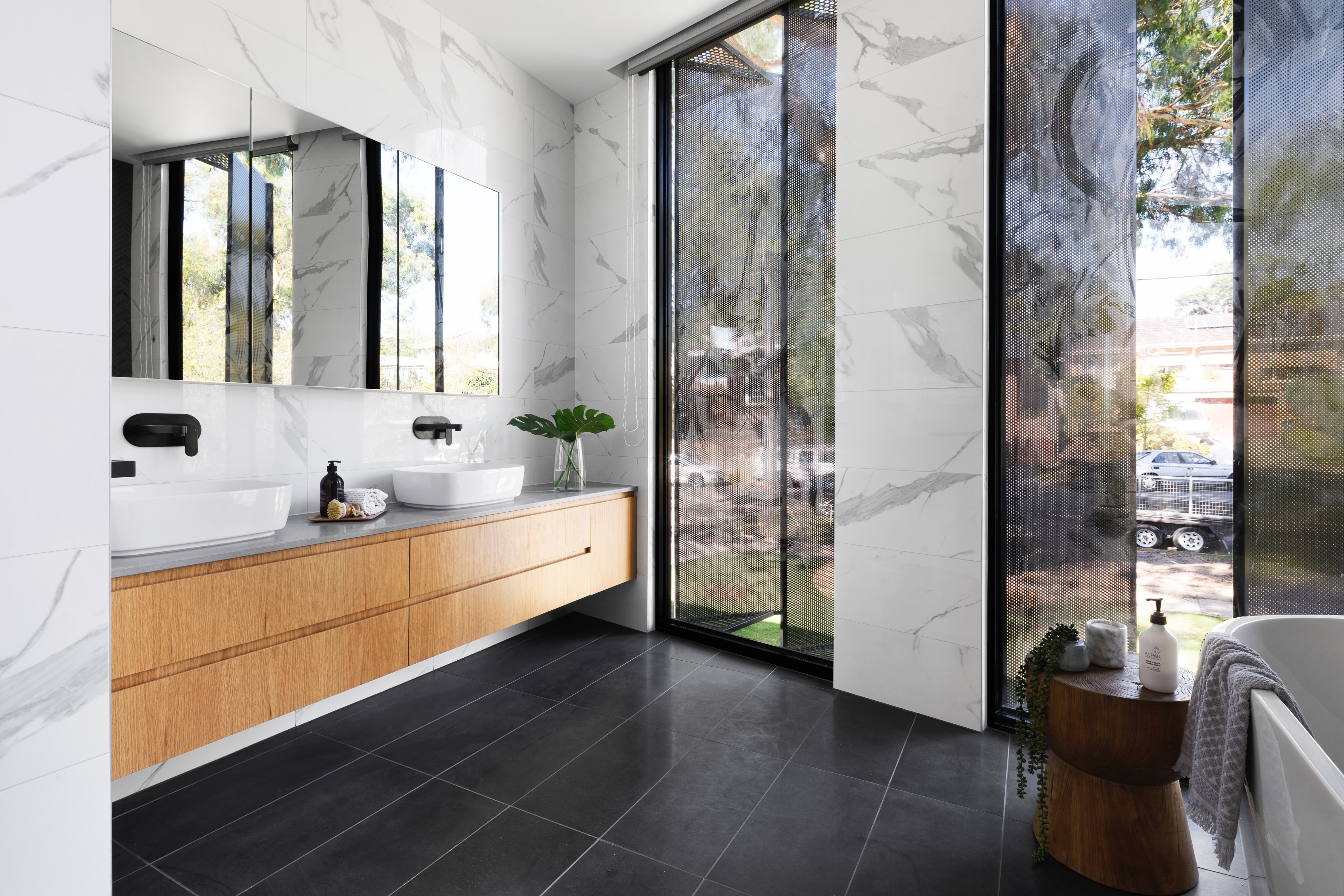
Choosing a door with a glazed panel is a wonderful way to add a little decorative flair to your doors without having to reach for a paintbrush or picking a complicated design that could age unfavourably. A stained glass panel in particular makes a beautiful design addition.
Another benefit of glazing in internal doors is that it lets more natural light flood into the room. As bathrooms tend to be quite small and dark, this added light can be a big bonus.
But there is also a drawback to having a transparent glass window in your bathroom door. This is one room that you usually want to keep private.
One way to get the best of both worlds is to get a bathroom door with frosted glass panel doors. Frosted glass will still let lots of additional light in but also obscure the lines of sight and protects your privacy.
Alternatively, you have an interior panel that is glazed with opaque glass. The opaque glass will not let as much light shine through but it will reflect up to 66% of light which will help create an airy and spacious look in smaller spaces.
Locks and Latches
Something else you need to consider in order to protect your privacy is whether to have a bathroom door with a lock, or a bathroom door handle without a lock.
This is a personal choice, and there is no concrete reason you can’t have a bathroom door without a lock. However, if you are comfortable having a door like this, you should also consider any other inhabitants and even guests to your home. Will they be as comfortable?
Of course, if you do choose to have a locking system, you need to get the right one. If privacy is a strong concern, you’re going to want a bathroom door without a keyhole in order to maintain full privacy.
If you’re looking for a bathroom door without a key, then there are other simple lock types you can use instead.
Thumbturn locks and other small, basic locking mechanisms are great for bathroom doors. They take little effort to use and are easier to install than a complicated lock with a key. They can be included as part of a handle too, to make installation even easier.
Mirrors
Mirrors are always useful in a bathroom, and having a bathroom door with a mirror is always a great way to save on space.
A spot to see your reflection in isn’t the only benefit a mirror will bring to a bathroom either. The smooth surface reflects light too, and a mirror can help a small, cramped space feel much bigger and brighter.
Ventilation
Any bathroom used for bathing will always benefit from having the maximum ventilation possible. The moist, steamy air that accompanies hot water use can breed damp and mould in small bathrooms, and even towels will contribute to this as they dry,
This is why it is always worth considering getting a bathroom door with ventilation built-in. A passive grill for airflow can be added to most timber doors, whether they are hollow or solid core.
The potential placement of the grill is something to consider if you’re thinking of getting a door with glazing in it though.
Opening
There is no set answer to the question ‘do bathroom doors have to open outwards?‘. Most internal doors come blank, with no hinges or groves pre-cut. This gives you complete control over how it is hung.
So it’s up to you to decide which way should bathroom door open. If you have a small bathroom, it might make sense to open the door outwards. However, many if not most, bathrooms open into hallways, which make outward-opening doors pretty awkward and obstructive.
Another thing to think about is how much clearance do you need for a bathroom door? Like all internal doors, you need enough space to open them fully to stop the door from being damaged by banging against things.
Finishing Your Door
Many companies allow to you pick between finished, unfinished and primed interior doors. When it comes to a bathroom door, these options carry extra importance.
As mentioned earlier in this article, bathroom doors need to be completely sealed to stop them from absorbing moisture. Most bathrooms spend a lot of time full of steam and damp air – you don’t want that seeping into your door and making it rot!
If you decide to go for an unfinished or primed door, make sure to consider what paint for the bathroom door will protect against moisture. A high-quality gloss or even eggshell will have water-repellent properties to protect your door, but you must make sure every inch of the door is covered. Even the sides and edges.
So, Which Bathroom Door Should I Buy?
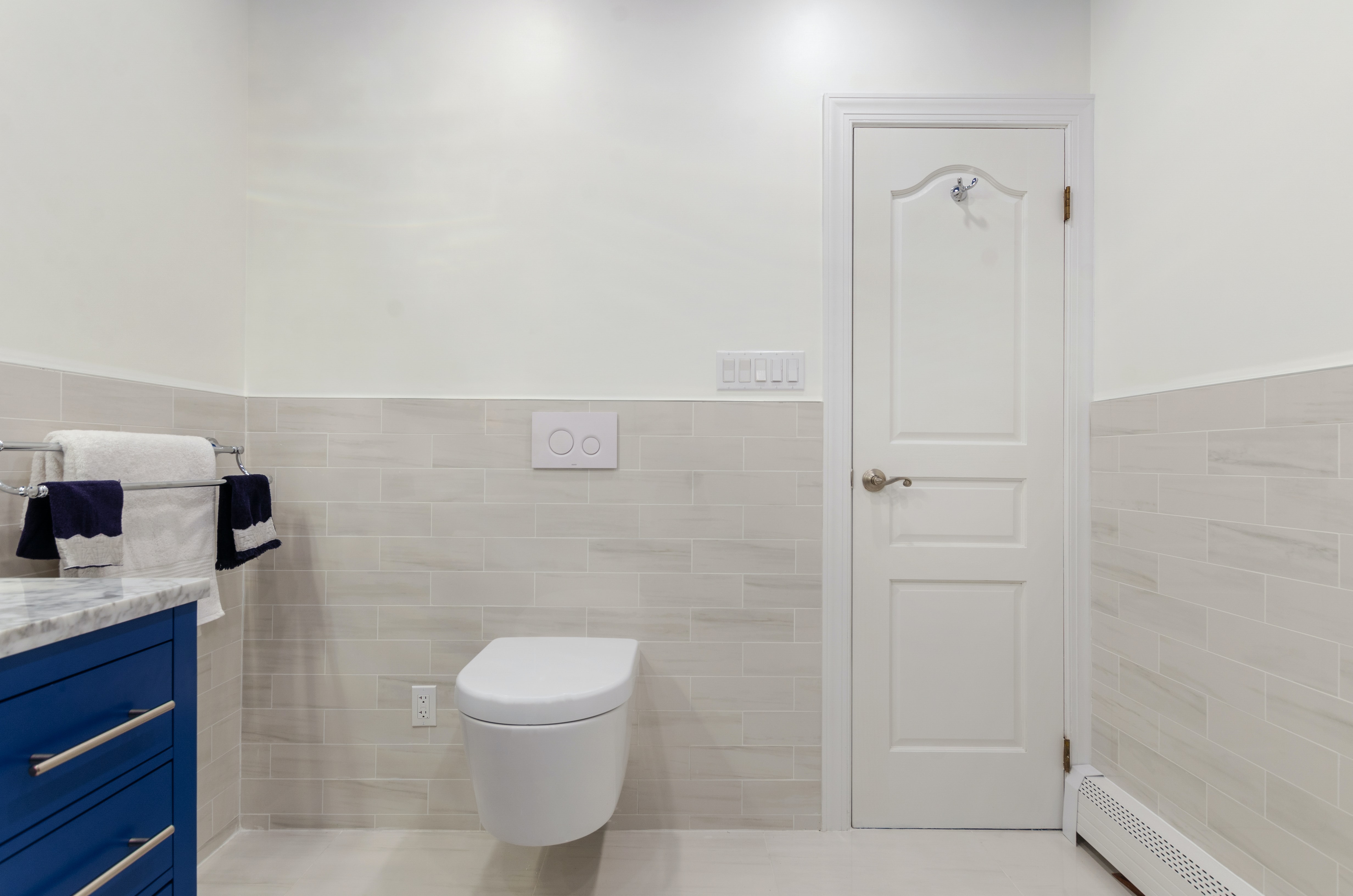
Ultimately, there is no ‘perfect door for a bathroom’ that suits everyone. It always comes down to personal preference. For small bathrooms, space-saving folding or sliding doors will be a practical choice. For small budgets, a flush door could be more suitable and can be tailored to many interior schemes. A busy, messy family, however, might choose a laminate door for its easy-clean properties.
We hope this article has helped you identify which type of bathroom door is right for your home. But if you need further help to choose bathroom doors for your home, you can always contact our expert team for even more guidance and support.
Related Posts:
"It is about the realities of what makes for an attractive, civilized, meaningful environment, not about fashion or what's in or what's out. This is not an easy job."
– Albert Hadley
Available in a range of sizes, designs and colours with a #MadeToMeasureDoors service available too.
Email [email protected] to book in for 2024.
















































